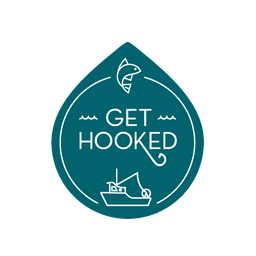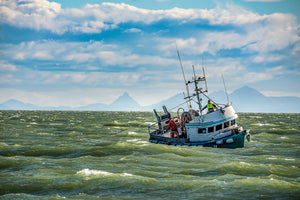Fishing In Bristol Bay
Jul 23, 2024
A note from Get Hooked founder (and past commercial salmon fisher) Victoria Voss on Alaskan Sockeye Salmon…
We are so excited to be offering wild-caught Salmon again to our members despite the California closure. This product is Alaskan Sockeye, since our own CA King Salmon fishery is currently closed to allow for drought recovery.
Growing up in Santa Barbara, my father and uncle, along with several other SB fishermen, would leave for 7 to 8 weeks each summer to head north and fish Salmon in Bristol Bay, AK. I begged to join them and was finally given the opportunity at 18. I loved it. Despite, or perhaps because of, the exhausting work, sleep deprivation and fatigue, it was a deeply satisfying exercise in mental fortitude. Also, I was fascinated by how it all worked. I thought I’d share a bit about what it’s like as an introduction to AK Sockeye on the Get Hooked menu…
The fish camp in NakNek, AK that we stayed in was owned and operated by Peter Pan Seafoods, the company my father (and now brother, see above) fished for as an independent contractor. Think of it like a very industrial summer camp…. there are old wooden bunk houses and a mess hall that serves meals for about 300 fishers in the camp, along with boat storage warehouses, net lockers, and vessel support (you can see the net lockers in this little video of my father talking about the Pebble Mine back in 2012).
Preparation for the season happens in camp, but once you set to fish, you generally won’t return to shore until the end of the season 5 or 6 weeks later. The boats are small, with 32 feet as the maximum permitted length. There’s barely enough room for bunks below deck and a sitting area in the cabin. The hardest part of fishing, the thing that sends many big strong men home, is the difficulty of being on a small boat for many weeks on end without returning to shore.
Bristol Bay comprises 5 fishing districts: Naknek-Kvichak, Egegik, Ugashik, Nushagak, and Togiak, each corresponding to the major river systems it connects to. Salmon return to the river of their birth to swim upstream and spawn before dying. To ensure a sustainable population returns to spawn, counters sit in towers up river from the fishing grounds and count the fish that have made it upstream. Escapement goals dictate how many fish need to make it upstream before fishing starts and how often it opens/closes throughout the season.
Fishers tune their radio dials to the public radio station and listen to updates of the fishing open/close periods every few hours, informing them when they can fish and for how long. With twenty hours of light in the summer ensures fishing can happen around the clock, and it does. But this light can also be disorienting and dysregulating. Sleep deprivation is a serious threat to safety and given among fishers. These small drift gillnet boats offload to larger “tenders” contracted by the processing companies to receive, weigh, and provide receipts for the fish out on the fishing grounds so that fishermen do not need to return up-river where 20 foot tide shifts can make coming and going impossible. The tenders then transport the fish to processing plants where they are prepared for consumption in multiple formats.
The Alaskan Sockeye fishery is near and dear to my heart and is considered a shining example of sustainable management. I fished for three summers in Bristol Bay before the birth of my daughter in 2009 and I have been wanting to return ever since. My younger brother has since taken over my father’s fishing permits and returns every summer. While the salmon we are offering is not from California, we still feel it meets the Get Hooked requirements of sustainability and local connection and we hope you enjoy it!


